Broomsedge (Andropogon virginicus)
Family:
Grass Family (Poaceae)
Other Names:
beard grass, broomsedge bluestem, sedge grass, whiskey grass.
Origin and Distribution:
Broomsedge is a native North American grass species that occurs primarily in the eastern half of the U.S. and California. It is found in dry meadows, pastures, fields, roadsides, waste places and other areas with low-fertility soils. Broomsedge is common in Ohio, except in the northwest region.
Plant Description:
Broomsedge is a clump-forming perennial grass that is most noticeable in the fall, when its stems and leaves turn a distinctive orangish-tan to reddish-brown color. It reproduces by seed and short rhizomes (horizontal underground stems).
Root System:
Dense, fibrous roots are produced from short rhizomes (horizontal underground stems).
Stems:
The smooth, erect, slightly flattened stems are 1 to 4 feet tall (sometimes up to 5 feet) and branched in the upper part. Unlike the hollow stems of most grass species, stems of broomsedge are filled with a white pith. Stems become stiff with age.
Leaves:
Leaves are folded in the bud. Mature leaves often have a whitish or bluish cast. The LEAF BLADE (free part of the leaf) is 6 to 12 inches long (sometimes up to 16 inches), 1/12 to 1/3 inch wide, and has rough margins. The base of the blade (where it attaches to the stem) is folded and covered with coarse, stiff hairs. The LEAF SHEATH(part of the leaf surrounding the stem) is smooth and flattened, with a distinct fold (especially the lower sheaths). Sheath margins may or may not have hairs. The ligule (projection on the inside of the leaf at the junction of the blade and sheath) is short (up to 1/32 inch long), membranous and fringed with hairs. AURICLES (appendages at the top of the sheath) are absent.
Flowers:
Each flower head is composed of 2 to 4 unbranched flower stalks (3/4 to 1 1/2 inches long). Flower stalks originate from the sheaths of upper leaves and remain partially tucked within the leaves. Flowers are arranged in clusters along the flower stalks, and are surrounded by long, silky, white hairs, giving them a feathery appearance.
Fruits and Seeds:
Seeds are yellowish-green to brown, linear, flattened on one side, and bearded with silky white hairs. The seeds are approximately 1/16 to 1/8 inch long, with long awns (bristles) 1 to 1 1/2 inches long.
Similar Species:
Little bluestem (Andropogon scoparius), a characteristic prairie species, closely resembles broomsedge, but its longer flower stalks hold the flowers completely free of the upper leaves. In addition, little bluestem flower stalks occur singly, rather than in groups of 2 to 4 like broomsedge.
Biology:
Flowering occurs between July and September. Broomsedge clumps turn a distinctive orangish-tan to reddish-brown color when dry, and persist into winter.
Toxicity:
None known.
Facts and Folklore:
Broomsedge is a poor forage grass, and is common on overgrazed pastures, especially where soil pH and fertility are low.
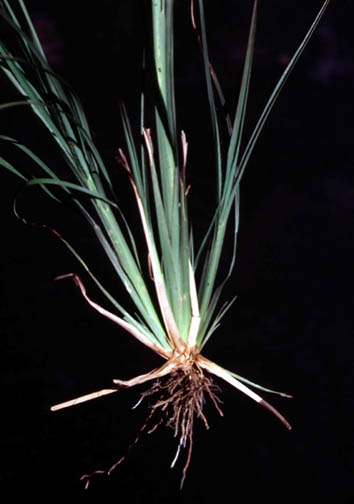
Broomsedge stem and leaf; note scraggly hairs at base of blade and flat, folded sheath.
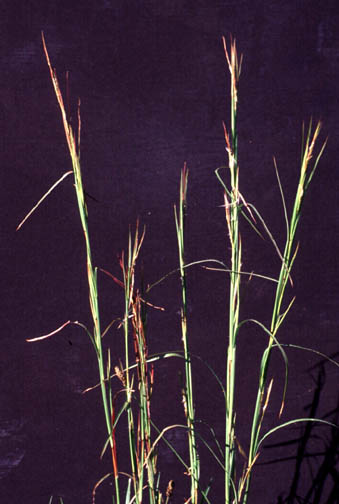
Broomsedge stem and leaf collar; note scraggly hairs and flat, folded sheath.
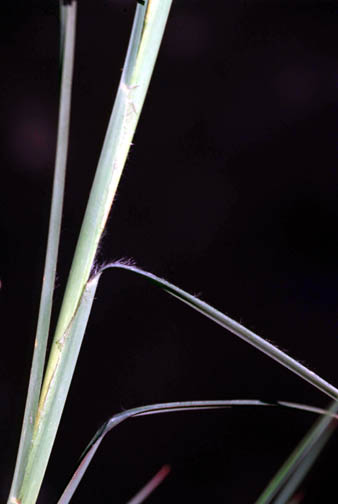
Broomsedge top of plant.
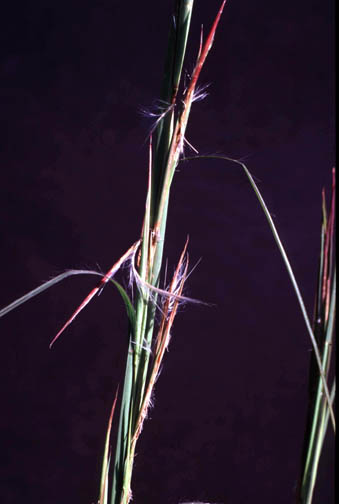
Broomsedge is a common sight in the fall along roadsides, especially in poor, acid soils.
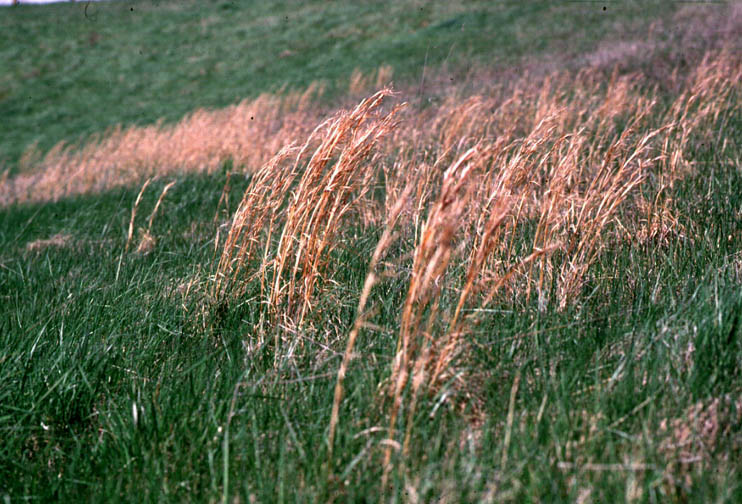
Broomsedge seeds with long awns emerging from inflorescence.

Individual broomsedge seeds with attached hairs and long awns (bristles).
